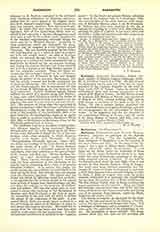

Barbastro (BARBASTRUM and CIVITAS BARBASTRENSIS), Diocese of, suffragan of the Spanish province of Huesca. The city (originally, perhaps, Bergidum or Bergiduna) is at the junction of the rivers Cinca and Vero. In the time of the Romans it was a part of Hither Spain (Hispania Citerior), afterwards called Tarraconensis. It was taken by the Arabs, under the leadership of Muza (711), and the name Barbaschter given to it, from which the name Barbastrum, according to the generally accepted opinion, is derived. It was held by the Saracens until about the year 1063, when it was retaken by Don Sancho Ramirez, King of Aragon. The Arabs once more obtained possession, but Aremengol IV, Count of Urgel, reconquered it, and after a third Arab conquest it was restored to Spain, in 1101, by Pedro I, King of Aragon, who, with the pope’s consent, constituted it an episcopal see, transferring the see from the ancient city of Roda, to Barbastro. The first bishop, Poncio, went to Rome to obtain the pope’s permission for this transfer. Many provincial and diocesan councils have been held in the city; the Cortes of Spain has met there occasionally, and during one of its sessions, King Ramiro, called the Monk, abdicated the crown (1134).
The diocese is bounded on the north by the Pyrenees, on the east and south by the Diocese of Lerida, and on the west by those of Huesca and Yaca. It is a suffragan of Saragossa and is composed of 154 parishes under the supervision of ten archpriests, or vicars. The population is about 240,000. The clergy number about 220, and there are 231 churches and 177 chapels. The diocese was annexed to Huesca in the sixteenth century, but was afterwards made independent and remained so until the Concordat of 1851, which annexed it once more to Huesca, preserving its name and administration. It is administered at present by the titular Bishop of Claudiopolis, Don Juan Antonio Ruano, preconized Bishop of Lerida. Among its bishops, Ramon II, who is venerated as a saint, and the above-mentioned Ramiro, called the Monk, a prince of the royal house of Aragon, deserve special mention.
Bartolome and Lupercio Argensola, historians and classical Spanish writers, were born in Barbastro. Bartolome is the author of the “Historia de las Molucas”, “Anales de Aragon”, and “Regla de Perfection”; Lupercio wrote three tragedies, “Isabel”, “Jebe”, and “Alejandro”, and some poems published with others written by his brother Bartolome. The cathedral, the episcopal palace, the seminary, and the college of the Clerks Regular of the Pious Schools, or Piarists, are among the most noted buildings in the city. Besides the seminary for the education of young ecclesiastics, there are, in the diocese, various communities of both sexes devoted to a contemplative life and the education of the young. The Piarists, the Sons of the Immaculate Heart of Mary, the Poor Clares, and the Capuchin nuns have foundations in the capital, the Benedictines in the town of Pueyo, and the Discalced Carmelites in Graus and Salas-Altas. There are schools in all the towns of the diocese.
TIRSO LOPEZ.

